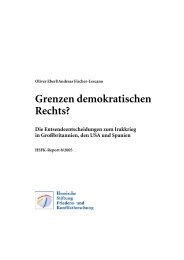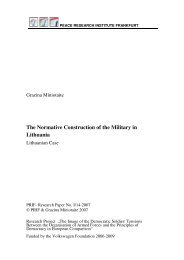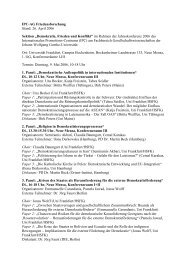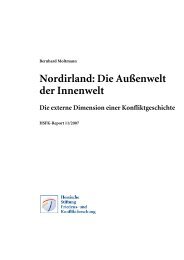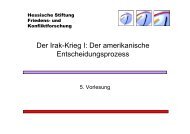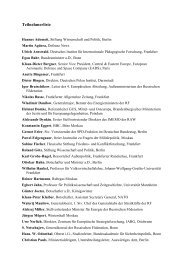From Exodus to Exitus Causes of post-war violence in El ... - eDoc
From Exodus to Exitus Causes of post-war violence in El ... - eDoc
From Exodus to Exitus Causes of post-war violence in El ... - eDoc
You also want an ePaper? Increase the reach of your titles
YUMPU automatically turns print PDFs into web optimized ePapers that Google loves.
<strong>From</strong> <strong>Exodus</strong> <strong>to</strong> <strong>Exitus</strong> 13<br />
<strong>El</strong> Salvador are the remittances, which are <strong>in</strong>come sent home <strong>to</strong> their families by migrants<br />
work<strong>in</strong>g abroad. In <strong>El</strong> Salvador <strong>in</strong> particular, remittances are hardly ever saved. Remittances<br />
not only fundamentally reduce <strong>in</strong>vestments (Cáceres/Saca 2006: 881), but also the<br />
supply and, at least <strong>in</strong> the longer term, because the attraction is no longer there <strong>to</strong> create<br />
employment by <strong>in</strong>vest<strong>in</strong>g locally, demand for employment <strong>in</strong> the Salvadorans own country.<br />
Remittances support oligarchic structures, because they make it possible <strong>to</strong> be a consumer<br />
without work<strong>in</strong>g or produc<strong>in</strong>g anyth<strong>in</strong>g. In the follow<strong>in</strong>g section I will show that <strong>in</strong> <strong>El</strong> Salvador<br />
there is a causal connection between the high levels <strong>of</strong> migration and remittances –<br />
the exodus and its economic consequences – and high homicide rates – the “exitus”.<br />
4.2 Specific, highly significant causes <strong>of</strong> <strong>violence</strong> <strong>in</strong> <strong>El</strong> Salvador<br />
4.2.1 Migration and remittances<br />
In a first step I shall demonstrate the exceptionally high volume <strong>of</strong> Salvadoran migration<br />
<strong>to</strong> the USA. Secondly, I shall illustrate the extremely high value <strong>of</strong> remittances with<strong>in</strong> the<br />
(socio)economic structure <strong>of</strong> <strong>El</strong> Salvador and the implication <strong>of</strong> this for the reduced importance<br />
<strong>of</strong> local production and labour. A third step will confirm the particularly high<br />
volume <strong>of</strong> remittances <strong>in</strong> <strong>El</strong> Salvador with the correspond<strong>in</strong>g economic and social implications<br />
<strong>in</strong> comparison with the rest <strong>of</strong> Central America. If this is successful, then it goes <strong>to</strong><br />
prove that there is a correlation – as <strong>El</strong> Salvador is also the country with the highest levels<br />
<strong>of</strong> <strong>violence</strong> <strong>in</strong> the region. This correlation will then be confirmed <strong>in</strong> a fourth step us<strong>in</strong>g<br />
comparison with<strong>in</strong> <strong>El</strong> Salvador itself (between the departments and municipalities). A<br />
fifth step will f<strong>in</strong>ally derive causality from these correlations.<br />
Step 1: The exceptionally high volume <strong>of</strong> migration by Salvadorans <strong>to</strong> the USA –<br />
<strong>in</strong> comparison with the rest <strong>of</strong> Central America<br />
In 2004 2.5 million <strong>in</strong>habitants emigrated from <strong>El</strong> Salvador, i.e. 20 % <strong>of</strong> the population<br />
and almost seven times the global average, primarily <strong>to</strong> the USA and then <strong>to</strong> Mexico. This<br />
is a real exodus. 90 % <strong>of</strong> these migrants are younger than 35 and 70 % younger than 26.<br />
Viewed statistically, the Salvadoran migrants tend <strong>to</strong> be male rather than female, aged<br />
between 18 and 44 years old, and from rural areas, with a slightly higher standard <strong>of</strong> liv<strong>in</strong>g<br />
and education than the average for those who do not migrate (Andrade-Eekh<strong>of</strong>f 2003:<br />
16). Neither the two <strong>to</strong>p qu<strong>in</strong>tiles nor the bot<strong>to</strong>m qu<strong>in</strong>tile <strong>of</strong> the population migrate, but<br />
<strong>in</strong>stead the second and third qu<strong>in</strong>tiles from the lowest, who are better <strong>of</strong>f <strong>in</strong> <strong>El</strong> Salvador<br />
than their counterparts <strong>in</strong> Honduras and Nicaragua, but worse <strong>of</strong>f than those <strong>in</strong> the USA.<br />
In the USA the Salvadorans represented the largest number <strong>of</strong> Central American residents<br />
with 1,201,002 <strong>in</strong> 2004. This is three times as many Salvadorans as Guatemalans and<br />
Hondurans, and almost four times as many as Nicaraguans. 42 % <strong>of</strong> the Salvadorans who<br />
migrated <strong>to</strong> the USA went <strong>to</strong> California. More than two thirds <strong>of</strong> them ended up <strong>in</strong> Los<br />
Angeles, where the American mara street gangs had their orig<strong>in</strong>s. If one compares the<br />
number <strong>of</strong> people deported from the USA, the rate for Nicaraguans is only a tenth <strong>of</strong> that<br />
for Salvadorans and Hondurans, as illustrated <strong>in</strong> Figure 3.





